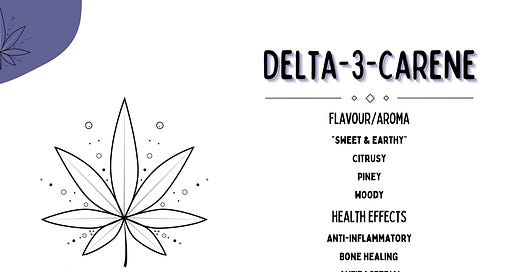Terpene of the Month: Delta-3-carene
From Anti-Inflammation to Sleep Aid: The Many Benefits of Delta-3-Carene
Keep your eyes peeled for an AusCannaReviews’s Birthday special edition coming this Thursday, March 6, 2025, but until then…. This month is all about Delta-3-carene!
Delta-3-carene is a bicyclic monoterpene, meaning it has a two-ring molecular structure, that can be found in various plants, including cannabis, cypress, pine, rosemary, basil, and cedar. Delta-3-carene is most commonly associated with turpentine and is responsible for its sharp, pungent scent. When it comes to cannabis, Delta 3 carene exhibits an aroma that is often characterized as “sweet and earthy,” with undertones of citrus, pine, lemon, cypress, or wood.
One of the most well-researched benefits of Delta-3-carene is its anti-inflammatory effects. A 2019 study published in the Journal of Ethnopharmacology examined the essential oils of Gynura procumbens, also known as “longevity spinach”, a medicinal plant rich in Delta-3-carene, widely used in tropical Asia. Researchers observed a significant reduction in swelling and pain in treated mice, suggesting its potential for managing inflammatory conditions like rheumatoid arthritis, multiple sclerosis, and fibromyalgia.
A 2008 study published in Phototherapy Research explored the effects of Delta-3-carene on bone metabolism in mice. The study found that Delta-3-carene stimulated osteoblast activity, the cells responsible for bone formation. While more research is needed, this means that Delta-3-carene could potentially be used to accelerate healing times for fractures and other bone-related injuries. There is also the possibility that Delta-3-carene may be beneficial for postmenopausal women at risk for bone loss or that it could help slow bone density loss in osteoporosis.
A 2006 study published in the Journal of Applied Microbiology aimed to determine whether essential oils extracted from trees and shrubs of the genus Juniperus exhibited antifungal activity. Results suggested that juniper essential oil could be used as an alternative antifungal agent against Candida albicans, a common fungal pathogen responsible for oral and genital yeast infections, and that Delta-3-carene was shown to be fundamental for this activity. While more research is still needed, this suggests that the topical application of Delta-3-carene may be beneficial as a therapeutic alternative to resistant antifungal drugs.
Emerging research suggests that Delta-3-carene, a primary terpene in Pinus halepensis (Aleppo pine), may offer neuroprotective benefits. A study published in Biomedicine & Pharmacotherapy in 2019 explored the essential oil of Pinus halepensis to assess its potential neuroprotective and nootropic effects. The study demonstrated that the Pinus halepensis essential oil improved memory impairments and decreased oxidative damage in the rat hippocampus. These results mean that Delta-3-carene could potentially be used to reduce inflammation in the brain associated with neurodegenerative diseases or that it may slow cognitive decline in Alzheimer’s patients by improving memory and learning abilities.
Another 2019 study published in Experimental Neurobiology on essential oils from pine trees was the first of its kind to examine the sleep-enhancing effects of orally administered Delta-3-carene. The findings suggest that Delta-3-carene interacts with the GABAergic system, which plays a key role in promoting relaxation and sleep. As a result, Delta-3-carene may have calming and sedative properties, making it a promising natural aid for those struggling with insomnia or anxiety-related sleep disturbances.
Lastly, although these reports are anecdotal, Delta 3 carene is said to contribute to the side effects of dry mouth/cottonmouth and red eyes among cannabis users.
Delta-3-carene stands out as a multifaceted terpene with a unique aromatic profile and a range of potential therapeutic applications. As research continues, I’m sure we’ll be hearing more about its benefits and applications within the medicinal cannabis community.
If you’re looking for medicinal cultivars on the Australian market that are high in Delta-3-carene…
Chemovar’s Bling Blaow (Total Delta-3-carene 1.36%)
PureKann’s Queen Curvee (Total Delta-3-carene 0.36%)
Tri-chome Australia’s Leprechaun THC 25% Night (Total Delta-3-carene 0.23%)
PureKann’s Coffee Breathe (Total Delta-3-carene 0.25%)
El Camino’s Mango Lemonade (Total Delta-3-carene 0.11%)
Stanley Brother’s Black Widow (Total Delta-3-carene 0.10%)
Stanley Brother’s Chocolate Haze (Total Delta-3-carene 0.06%)
Stanley Brother’s Santa Marta (Total Delta-3-carene 0.06%)
Tasmanian Botanics’s Opal (Total Delta-3-carene 0.04%)
MedCan’s Ultra Sour (Total Delta-3-carene 0.03%)
This Substack aims to provide anecdotal information from my personal experiences in hopes it will lead to meaningful conversations between my readers and their healthcare professionals about medicinal cannabis.
I have no formal training in medicine or science. This article does not constitute medical advice.







This is really insightful! Thanks for the education on this, I’ve been curious about its effects. Love the terpene of the month!